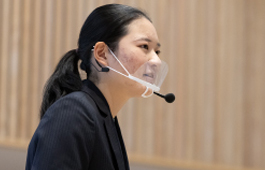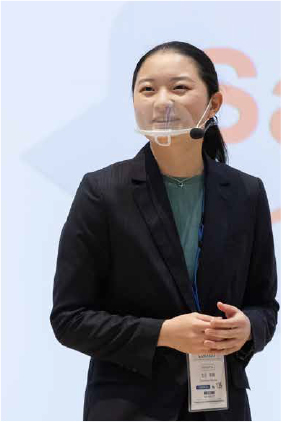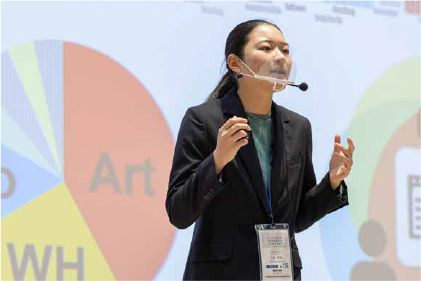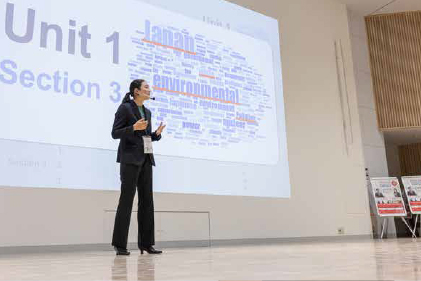
土谷 茉楠 Tsuchiya Mana
神田外語大学 外国語学部 2年
One day in science class, we were studying about springs. The teacher taught about elastic energy and Hooke’s Law. But suddenly, one student said, “Hey, it’s the same as math!” Then the teacher called the math teacher and she started teaching instead. Of course, as a math teacher, she focused on calculation and formula. So in this class, we studied the same topic from different subject perspectives. It was super exciting. That’s why I remember clearly.
This experience made me wonder, when different subjects have similar topics, why don’t you combine them? That way we can remove the overlaps and study more efficiently. The same goes for all subjects. Now in most schools, we study each subject separately. But I believe there should be some connections between them.
So, what if they are taught across the boundaries? And what if we can find connections with our daily life as well? Actually, I’m not the only one who thinks this way. Hence, there is an expression for that. This idea is called transdisciplinary education.

This education model has been encouraged for such a long time. But in reality, due to its costing quite a lot of time and in-depth thoughts, most schools haven’t achieved it yet. But according to Dobozy and Dalziel, “The transdisciplinary framework seems to be most helpful when it includes a curriculum planning tool.”
That’s why I created the app SmarT. This app promotes high school teachers’ collaboration in order to achieve transdisciplinary education.
SmarT has two outstanding features. Subject integration and material recommendation.
Let me explain about subject integration first.
So let’s say you’re a geography teacher, teaching class 1. This is a part of the annual schedule that you can get from the textbook publishing company. By analyzing this schedule and the textbook, what SmarT does is to collect keywords. More specifically, SmarT finds out how many times a certain word appears in which section of which unit.
For example, when unit 1 section 3 is about environmental issues in Japan, the words like Japan, waste, environmental and pollution appear a lot. This process is done to all subjects.
So when you have a section about culture, SmarT may suggest, “how about combining this section with this history one and the art one?” This suggestion is made based on the keywords that SmarT collects and the result of material searching, which I’ll explain later.
And once SmarT finds connections like this, it offers an integrated schedule. For example, say, you teach geography on Monday 3rd period, Wednesday 2nd period and Thursday 5th period, and the others have schedules like this.
Now, if three of your schedules are combined for a week, starting from Monday, the order of teaching should be like this, right? Then SmarT converts this one into this vertical one.

So what’s the strong point about this schedule? Yeah, some applications have a co-teacher system, which is supposed to be used for teachers to work together. And with this system, they can see each other's lesson plans.
But the problem is they don’t visit you that often. In other words, they don’t see your schedule until they "try to" see it.
On the other hand, this schedule is shared with all the teachers concerned and you can fill in just like you’re doing right now. You don’t have to visit the others' lesson plans every time. Instead, you can check them, while making yours.
Also, referring to the others, you can change or tweak the plan right away.
For example, you noticed that before your class, students are learning about how to make natural dyes from plants. So you might feel like changing this part into a more related one. That way, you can help students more to find connections between the subjects.
So then how does SmarT recommend online materials? As I said before, SmarT collects keywords from each subject. And using these keywords, SmarT searches materials online and suggests the suitable one for your integrated plan.
So let me give you an example. This is an actual article you can find on the Internet and on the right is the actual data that I got. This time I found the article and collected the data, but of course, SmarT will do it instead of us. In addition to this process, SmarT checks which subject each of these words belong to and based on the result, it chooses sections to be integrated and then, it recommends this kind of website to clarify the connection.
So how can teachers use them? Well, it depends on teachers. Of course they can use them in class as teaching materials. Today, I’d like to suggest two ways to make efficient use of them.
My first suggestion is to use them to create a comprehensive exam.
Instead of having exams separately, how about making a test that covers all of the subjects? That way, you can divide tasks such as making and grading tests with the other teachers, and also the students don’t need to take so many exams. In short, it can reduce the burden on both teachers and students.
The other suggestion is to assign an integrative paper or project.
How about letting students make their own costumes? As a geography teacher, you can ask students how their choice of fabric is related to the climate. The art teacher may teach how to dye or paint the clothes and the history teacher may let the students write a hypothetical story about how their costumes were developed.
It would be ideal if you could schedule a class that all of you can join so that students can get advice from different teachers from different disciplines at the same time, which helps them connect these subjects more easily.
Either way, students are required to think beyond the subject boundaries, which is the first step to transdisciplinary education.
According to the organization International School Parent, this kind of experience cultivates students’ deeper conceptual understanding as it allows them to see the same things from different perspectives.
And by understanding deeply, their problem-solving skills are promoted. Combining their knowledge, they can try to solve more complicated problems.
And once they do it, the sense of accomplishment increases their intrinsic motivation and makes them feel like studying more.
This virtuous circle makes transdisciplinary education sustainable.
But in the first place, how should I get users? Well, first I’d ask some high schools that are already trying subject integration, to use this app and give me some feedback, and also the government to further promote the idea of transdisciplinary education recommending SmarT. After that, I’d market to all the high schools in Japan.
Now, the world we live in is so messy and chaotic with tons of unsolved complicated problems. That’s why we have the concept of subjects in order to understand things one by one, focusing on one perspective at a time. And it’s been successful so far.
But just to let you know, subjects are just the collections of the same perspectives of this world. Now what we need is to rebuild the connections to address various kinds of issues in this complexity, which many of us aren’t aware of.
I strongly believe we can reach this goal by using SmarT in education. With this great application, let’s achieve transdisciplinary education together. Thank you for listening.
ある日、理科の授業で私たちはバネについて勉強していました。先生は弾性エネルギーやフックの法則について教えてくれました。ところが突然、一人の生徒が「あれ、数学と同じだ!」と言いました。すると、先生は数学の先生を呼んで、その数学の先生が代わりに教え始めました。もちろん、数学の先生なので計算や式が中心でした。このクラスでは、同じトピックを異なる科目の視点から勉強したわけです。とてもわくわくしました。だからこそ、はっきりと覚えているのです。
この経験から私は、異なる教科で似たようなテーマがある場合、それらを組み合わせることができるのではないかと考えました。そうすれば、重複を取り除き、より効率的に勉強することができます。これはすべての教科に言えることです。現在、多くの学校では各教科を別々に勉強しています。しかし、私はそれらの間に何らかのつながりがあるはずだと考えています。
では、教科の垣根を越えて教えたとしたらどうでしょう。そして、私たちの日常生活にも関連性を見出すことができるとしたらどうでしょう。実はこのように考えているのは、私だけではありません。ゆえに、それを表す言葉もあります。このアイデアは、学際的な教育(トランスディシプリナリー教育)と呼ばれています。

この教育モデルは、長い間、奨励されてきました。しかし実際には、かなりの時間と深い思考を要するため、ほとんどの学校ではまだ実現していません。しかし、DobozyとDalzielは、「トランスディシプリナリーフレームワークは、カリキュラムを計画するためのツールが含まれている場合に最も役立つようです」としています。
そこで、私はSmarTというアプリを作りました。このアプリは、学際的な教育を実現するために、高校の教師のコラボレーションを促進するものです。
SmarTには2つの優れた機能があります。「教科統合」と「教材推薦」です。
まず、教科統合について説明します。
例えば、あなたが地理の先生で、1組を担当しているとします。これは、教科書出版社からもらえる年間スケジュールの一部です。この時間割と教科書を分析して、SmarTが行っているのは、キーワードの収集です。具体的には、SmarTはある単語がどの単元のどのセクションに何回出てくるかを調べます。
例えば、ユニット1のセクション3が日本の環境問題について書かれている場合、日本、廃棄物、環境、汚染などの単語が多く出てきます。この作業はすべての教科に行われます。
文化についてのセクションがあるとき、SmarTは 「このセクションを、この歴史のセクションや美術のセクションと組み合わせてはどうでしょうか?」と提案することがあります。この提案は、SmarTが収集したキーワードと、後に説明する資料検索の結果に基づいて行われます。
そして、SmarTはこのようなつながりを見つけたら、統合的なスケジュールを提案します。例えば、あなたが月曜3限、水曜2限、木曜5限に地理を教えていて、他の共同の先生方はこのようなスケジュールだとします。
さて、3人のスケジュールを1週間、月曜日始まりで統合した場合、教える順番はこんな感じになるはずですよね。するとSmarTは、これをこのような縦長のものに変換してくれるのです。
では、このスケジュールの長所は何でしょうか。アプリケーションによってはco-teacherシステムという、教師同士が連携して作業することを想定したシステムがあります。このシステムでは、お互いのレッスンプランを見ることができます。

しかし、問題は、彼らがそれほどあなたのクラスに頻繁に訪問してくれないことです。つまり、彼らはあなたのスケジュールを「見ようとする」までは見ないのです。
一方、このスケジュールは関係するすべての先生方に共有されていて、あなたは今やっているように記入することができます。毎回、他の人のレッスンプランを見に行く必要はありません。他の人のレッスンプランを確認しながら、自分のレッスンプランを作ることができます。
また、他の人を参考にして、すぐに計画を変更したり、手を加えたりすることもできます。
例えば、自分の授業の前に、生徒が植物から天然の染料を作る方法を学んでいることに気づいたとします。そこで、この部分をより関連性の高い部分に変更したいと思うかもしれません。そうすれば、生徒がテーマ間のつながりを見つけやすくなります。
では、SmarTはオンライン教材をどのように推奨しているのでしょうか?先ほど申し上げたように、SmarTは各教科のキーワードを収集します。そして、そのキーワードをもとに、SmarTはオンライン教材を検索し、統合プランに適した教材を提案します。
では、例を挙げてみましょう。これはインターネット上にある実際の記事で、右は実際に得られたデータです。今回、私が記事を探してデータを集めましたが、もちろん、SmarTが代わりにやってくれます。さらにSmarTは、これらの単語がどの科目に属しているかをチェックし、その結果に基づいて、統合するセクションを選択し、さらにその関連性を明らかにするために、このようなウェブサイトを推奨します。
では、先生方はどのように活用できるのでしょうか?それは、先生方次第です。もちろん、教材として授業で使うこともできます。しかし、私はそれらを効率的に利用するための2つの方法を提案したいと思います。
ひとつ目の提案は、総合的な試験を作るために使うことです。
科目ごとに試験をするのではなく、すべての科目を網羅した試験を作ってはどうでしょうか。そうすれば、テストの作成や採点などの作業を他の先生方と分担することができますし、生徒もそれほど多くの試験を受ける必要がありません。つまり、先生と生徒の両方の負担を減らすことができるのです。
もうひとつの提案は、統合的なレポートやプロジェクトを課すことです。
生徒に自分で民族衣装を作らせるのはどうでしょうか。地理の先生であれば、生地の選択が気候とどのように関係しているかを生徒に聞くことができます。美術の先生は、服の染め方や塗り方を教えたり、歴史の先生は、自分の衣装がどのようにして開発されたのか、仮のストーリーを書かせたりすることができます。
関係する先生方全員が参加できるクラスを予定することができれば、生徒は同時に異なる分野の先生からアドバイスを受けることができ、これらの科目をより簡単に結びつけることができるので理想的です。
いずれにしても、生徒は教科の枠を超えて考えることが求められ、それが学際的な教育の第一歩となります。
「インターナショナル•スクール•ペアレント」という団体によると、このような経験は、同じものを異なる視点から見ることができるため、生徒のより深い概念的理解を育みます。
また、深く理解することで、問題解決能力が促進されます。自分の知識を組み合わせて、より複雑な問題を解決しようとすることができます。
そして、いったん解決すると、その達成感から内発的なモチベーションが高まり、もっと勉強したいと思うようになります。
この好循環が、学際的な教育を持続可能なものにしているのです。
しかしそもそも、どうやってユーザーを獲得すればいいのでしょうか。まず、すでに教科統合に取り組んでいる高校にこのアプリを使ってもらい、フィードバックをもらいます。また、政府にもSmarTを推奨しながら、学際的な教育をさらに推進してもらいます。その後、日本中の高校に売り込みたいと思います。
今、私たちが生きている世界は、未解決の複雑な問題が山のようにあって、とても混沌しています。だからこそ、ひとつひとつの物事を理解し、ひとつの視点に集中するために教科という概念があるのです。そして、それは今のところ成功しています。
しかし、念のためにお伝えすると、教科というのは、世の中の同じような視点が集まっているだけにすぎません。今、私たちが必要としているのは、この複雑さの中にあるさまざまな問題を解決するためにこれらのつながりを再構築することであり、私たちのほとんどはそれに気付いていません。
しかし私は、SmarTを教育に活用することで、この目標を達成できると確信しています。この素晴らしいアプリケーションを使って、一緒に学際的な教育を実現していきましょう。ご清聴ありがとうございました。